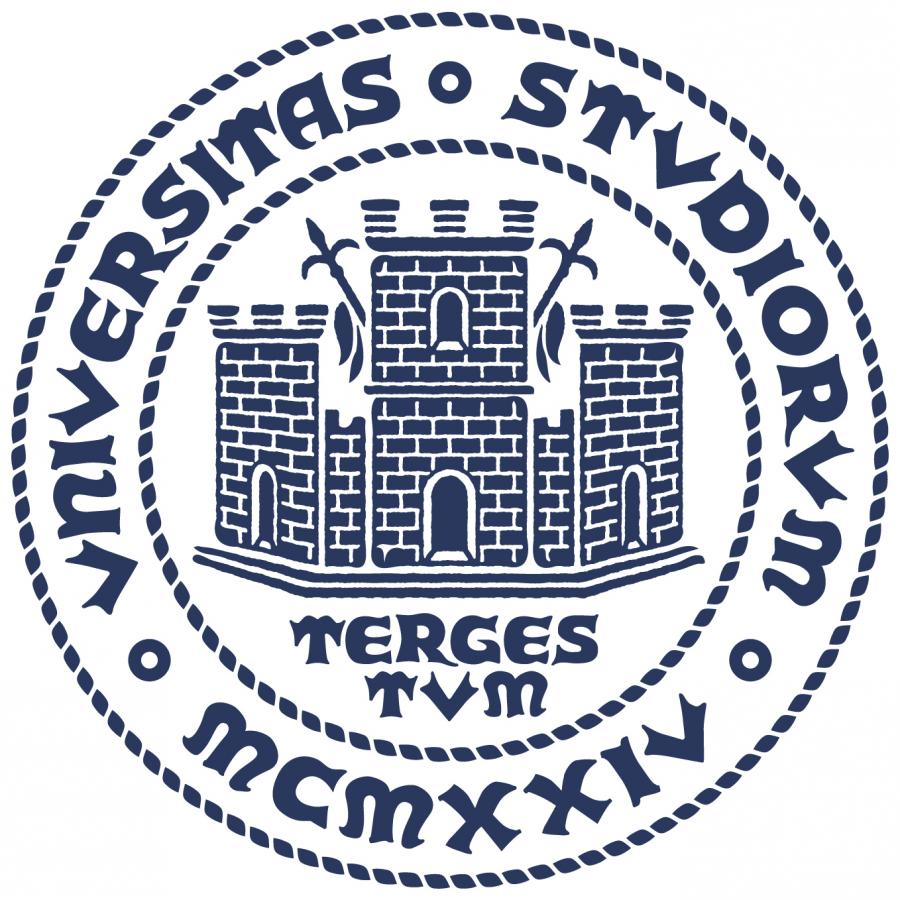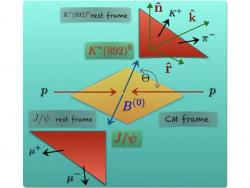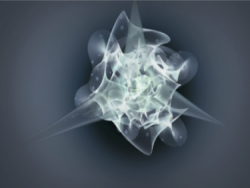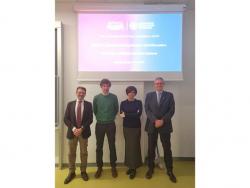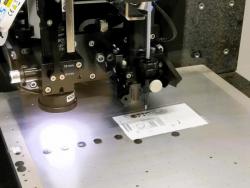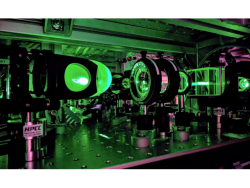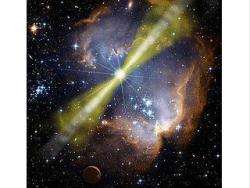- Home
- Department
- Research
- Teaching
- Post Graduate Studies
- Knowledge Transfer
- How To
Particle Physics at the Large Hadron Collider: CMS at CERN
Research Strand:
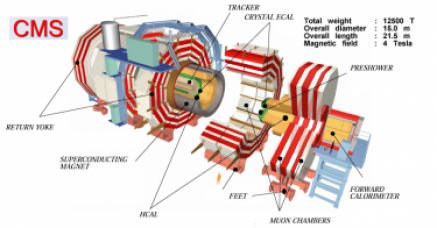
The acronym CMS stands for "Compact Muon Solenoid".
Most detectors for particle physics are based around a magnet system of one sort or another, so as to make it easier to measure the momenta of charged particles. In this, CMS is no exception: in fact, it was decided to use a large superconducting solenoid, about 12 m in length length and with an inner diameter of about 6 m.
The field strength is 3.8 Tesla - about 100,000 times that of the earth's magnetic field. This is the largest magnet of its type ever built, and allows all the tracking devices and calorimeters to be placed inside the coil of the solenoid - resulting in a very compact detector. Outside the coil is a steel "return yoke". This yoke is built in layers, interspersed with muon detectors; the configuration of the magnetic field means that the momentum of muons will be measured both inside the coil (by the tracking devices) and outside it (by the muon chambers). Muons are extremely important in particle physics since they indicate that "something interesting has happened" and can therefore be used to help find that elusive "needle in a haystack".
The whole CMS detector is about 21 m long and 16m wide, with a weight in excess of 12,500 tonnes. Even if the access shaft were large enough to accommodate the complete detector (which is as big as the underground cavern!) it would not be possible to lower the detector down into the cavern. For this reason, the detector has been given a modular design, enabling it to be constructed and tested piece by piece.
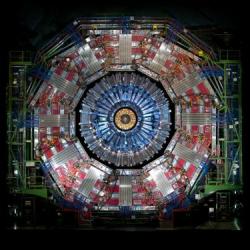
Using data collected up to June 2012 CMS has observed an excess of events at a mass of approximately 125 GeV with a statistical significance of more than five standard deviations above background expectations. The probability of the background alone fluctuating up by this amount or more is about one in three million. The evidence is strongest in the two final states with the best mass resolution: first the two-photon final state and second the final state with two pairs of charged leptons (electrons or muons). For this mass, the decay width is in the order of a few score of keV - the measured mass resolution in the two-photons final state is entirely dominated by the energy resolution of the electromagnetic calorimeter (ECAL) used to detect and measure the photons. That is the reason why CMS has placed such great emphasis on the performance of its ECAL.
CMS has interpreted this to be due to the production of a previously unobserved particle with a mass of around 125 GeV.
The new particle observed at about 125 GeV is compatible, within the limited statistical accuracy, with being the Standard Model Higgs boson. However, more data are required to measure its properties such as decay rates in the various channels (γγ, ZZ, WW, bb and ττ) and ultimately its spin and parity, and hence ascertain whether it is indeed the Standard Model Higgs boson or the result of new physics.
In 2013 Peter Higgs and François Englert were awarded the Nobel Prize for Physics, for their independent prediction of the existence of the Higgs boson.
The Trieste group has been involved since many years in various sectors of the experiment, having contributed to the activities of the electromagnetic calorimeter and to the development and management of software and computing systems of the Collaboration. The group also participates in precision studies of the Standard Model processes that are important backgrounds for searches of new physics, and in the realization of the new minimum ionizing particle (MIP) Timing Detector (MTD) of CMS.
Images and plots from the CMS Higgs Seminar (4 July 2012)
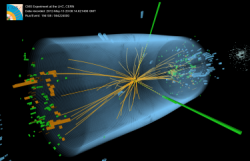
Event recorded with the CMS detector in 2012 at a proton-proton centre-of-mass energy of 8 TeV. The event shows characteristics expected from the decay of the SM Higgs boson to a pair of photons (dashed yellow lines and green towers).
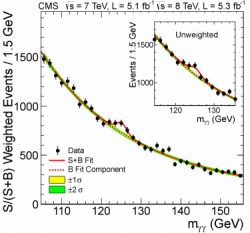
Di-photon (γγ) invariant mass distribution for the CMS data of 2011 and 2012 (black points with error bars). The data are weighted by the signal to background ratio for each sub-category of events. The solid red line shows the fit result for signal plus background; the dashed red line shows only the background.
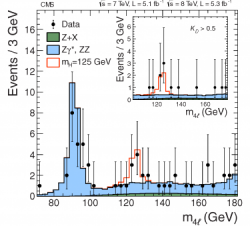
Distribution of the four-lepton reconstructed mass for the sum of the 4e, 4μ, and 2e2μ channels. Points represent the data, shaded histograms represent the background and un-shaded histogram the signal expectations. The distributions are presented as stacked histograms. The measurements are presented for the sum of the data collected at centre-of-mass energies of 7 TeV and 8 TeV.
The same distributions obtained with all the data collected during Run2 (2015-2018) at the center of mass energy of 13 TeV are shown below.
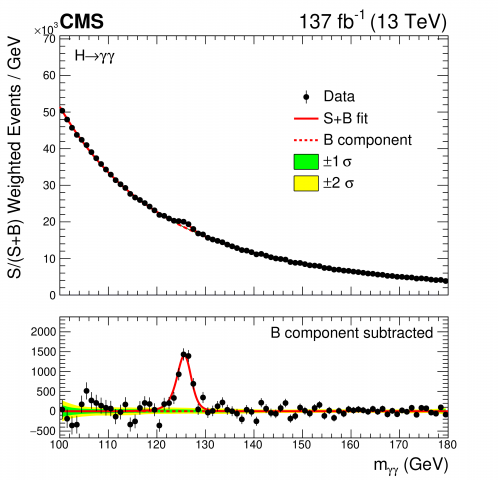
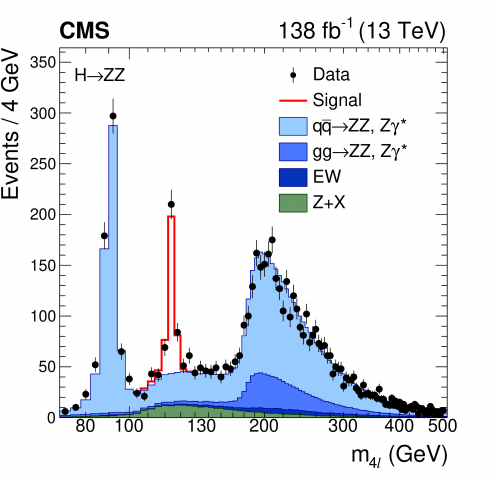
Info
Last update: 02-17-2025 - 12:53
